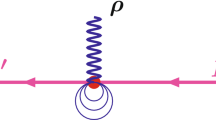Abstract
THE spectrum of the mesons near their place of production can be deduced from the spectrum observed near sea-level. The probability of a meson reaching sea-level with a final momentum p is, according to Euler and Heisenberg1, given as follows: All quantities have been expressed in terms of momenta, the symbols having the following meaning: q = 2,000 Mev./c., the momentum loss on traversing the atmosphere. p1 = 200 Mev./c, the momentum loss on traversing the atmosphere lying above the meson-producing layer. , with H the height of the homogeneous atmosphere, ï the average life of the meson, μ mass of the meson.
Similar content being viewed by others
References
Euler and Heisenberg, Ergeb. exakt. Naturwiss., 17, 1 (1938).
Nature, 158, 414 (1946).
Author information
Authors and Affiliations
Rights and permissions
About this article
Cite this article
JANOSSY, L., WILSON, J. Interpretation of the Meson Spectrum Near Sea-Level. Nature 158, 450–451 (1946). https://doi.org/10.1038/158450b0
Issue Date:
DOI: https://doi.org/10.1038/158450b0
- Springer Nature Limited
This article is cited by
-
Current problems of high energy cosmic ray primaries
Acta Physica Academiae Scientiarum Hungaricae (1972)
-
Sull'eccesso positivo della radiazione cosmica
Il Nuovo Cimento (1948)





